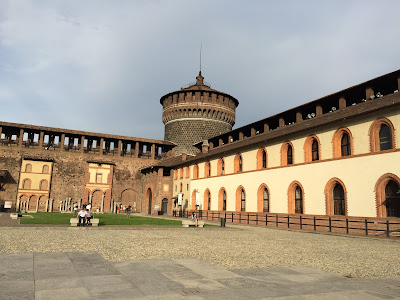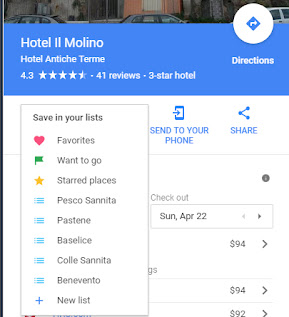Thursday night my husband and I landed in Newark Liberty Airport after a long flight from Rome. Our genealogy vacation was over.
 |
|
At the Archivio di Stato,
Corso Garibaldi, Benevento. |
Our flight landed at 9:30 p.m., but customs took forever. We were in our own car by 11:30 p.m. with a 90-minute drive home ahead of us.
A massive storm and tornadoes knocked out the electricity at home two days earlier. We arrived home at 1:00 a.m. and entered the house in pitch blackness. Our dog was barking and our son had woken up to let us in.
After finding our toothbrushes in our suitcases, we all went to bed. I didn't have time to process my incredible journey through my ancestors' towns. This had been our fourth trip to Italy. We'd seen most of the tourist sites already. After two nights in Rome, we headed to Benevento, the province in Southern Italy where all my roots are found.
On May 10, we rented a car and drove two and a half hours from Rome to the city of Benevento. If you're American, think of the city of Benevento as the county seat.
We checked into the Hotel Antiche Terme and took the short walk to Pizzeria Romano—my cousin Vincenzo's restaurant. We could see Vincenzo inside, but there were workers trying to install a new sign and doorway, and I felt it was unsafe to go any closer. I couldn't get his attention.
 |
Carefully turning the pages of
World War I military records in Benevento. |
Dov'è l'archivio di stato?
They told me to go another block and look for an obelisk. I would find the archives there.
Once I found it, nothing could stop me from going inside. I had prepared a couple of Italians sentences to say in the hopes of seeing my grandfather's World War I military record. So that's what I began to say.
Mio nonno era Adamo Leone di Baselice. Era un prigioniero di guerra con l'esercito italiano nella prima guerra mondiale.
Before I'd finished, I was directed to go upstairs where someone would help me. Not sure where to go, I found two workers and began my statement again.
Mio nonno era Adamo Leone di Baselice. Era un prigioniero di guerra con l'esercito italiano nella prima guerra mondiale.
The two workers conferred with one another and called in another woman. She gave me a form to fill out stating who I was and that I wanted this document for genealogical purposes. She gave me a second form giving me permission to photograph any documents. When I finished the forms, she had me turn around. A big volume was on the table, tied shut with white ribbons.
This was register #67. That's the one I'd asked for, having looked up the document number for my grandfather on their website.
 |
| My grandfather's Italian military record from World War I. |
If you have an Italian ancestor from the Benevento province who served in the military, start at this page. Find your ancestor's last name (Cognome), enter his first name (Nome). If you know it, choose his birth place (Luogo di nascita), and choose the year he was born (Classe). Click search (Ricerca). If you get more than one result, hopefully you'll know the correct man by his birthdate.
I clicked my grandfather's name in the search results. I found the two numbers I needed: Registro (register) 67, Matricola (roll list) 21728. So I needed to ask for register 67 and look in it for document 21728.
I untied the white ribbons and opened register 67. I was surprised to be able to handle the pages. No white gloves, no one watching me all that closely.
I turned the pages, approaching document number 21728. Instead, I found a big gap. The numbers jumped significantly. Not wanting to panic, I turned to a later section in the book and found document numbers closer to 21728.
Finally, I found it. Leone Adamo. My grandfather. One year ago I wrote about my grandfather's World War I experience. He had told us only that he'd been a prisoner of war and had to eat rats to keep from starving. Research led me to the 1917 Battle of Caporetto in northern Italy. More than a quarter of a million Italian soldiers were captured.
With such a large number, there's certainly a chance my grandfather was taken prisoner in that battle. The men were kept in camps in Austria, including Mauthausen. There were so many prisoners, the conditions were awful and they were not well cared for.
Now I have an official record of my grandfather's military service. He served in the infantry from 1911 to 1914. At that time he was allowed to leave the military and follow his first cousins to New York City.
My grandfather received a call to arms in May 1915. He left his new home in America in August, sailing back to Italy. He rejoined the infantry on 9 September 1915. He was promoted to Corporal on 1 January 1917. On 6 November 1917, my grandfather was taken prisoner, held in Matausen, Austria.
It sure looks as if my theory, formed a year ago in my blog, was correct. He does seem to have been taken prisoner in the Battle of Caporetto which lasted from 24 October to 19 November 1917 on the Austro-Italian front. Matausen, or Mauthausen, was later turned into a World War II concentration camp. (Seeing the movie "The Photographer of Mathausen" had me sobbing uncontrollably at the end, knowing my grandfather had been there.)
Exactly one year after his capture, my grandfather was repatriated at Castelfranco Emiliano in northern-central Italy. The army gave him some small payment for this lost year of his life. They sent him on on unlimited leave to recuperate in light of his loyalty and faithful service.
After his recovery, on 15 February 1920, Corporal Leone left Italy once again for New York City. Shortly afterward, the army awarded him a commemorative medal of his service in the war.
 |
| Looking at my grandfather's 1891 birth record. |
This one page from the archives is packed with information about my grandfather. At age 20, he was already a shoemaker. His hair was curly (like mine), his coloring was rosy, his teeth were healthy. His hair and eyes were brown. He was 5'2", which seems impossible because of how tall and proud he always held himself. He could read and write.
I was in another world, standing there in the Archivio di Stato poring over that page. I didn't realize there was a new person in the room. A young man told me they had my grandfather's birth record and he would bring it to me.
I had downloaded his 1891 birth record from the Antenati website, but of course I wanted to see the real thing! When he brought me the book, I was so surprised to see how large it is. It was at least 18 inches high and his record took up two-thirds of the page. I really think the group of workers was as happy as I was.
It wasn't my plan to walk into the archives that day. I was saving it for the next morning. But I couldn't stop myself, and it couldn't have turned out better.
And this was only Step 1 in my genealogy journey. To be continued…











